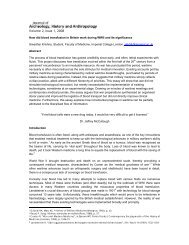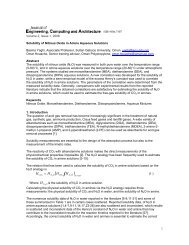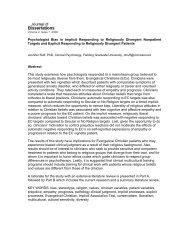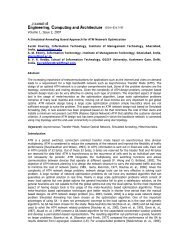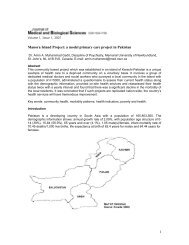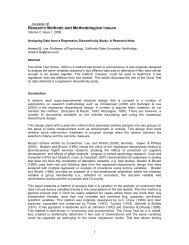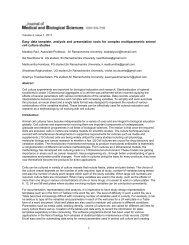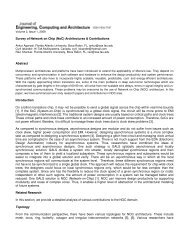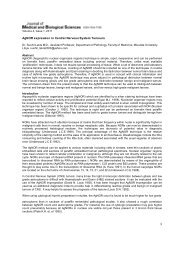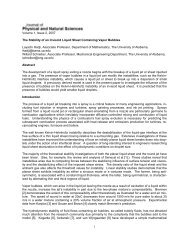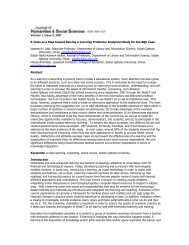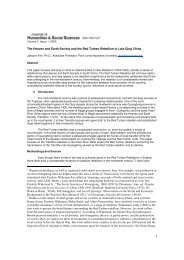Concentration and Speciation of Arsenic in South African Soil ...
Concentration and Speciation of Arsenic in South African Soil ...
Concentration and Speciation of Arsenic in South African Soil ...
You also want an ePaper? Increase the reach of your titles
YUMPU automatically turns print PDFs into web optimized ePapers that Google loves.
Volume 1, Issue 2, 2007<br />
<strong>Concentration</strong> <strong>and</strong> <strong>Speciation</strong> <strong>of</strong> <strong>Arsenic</strong> <strong>in</strong> <strong>South</strong><br />
<strong>African</strong> <strong>Soil</strong> Contam<strong>in</strong>ated by Historically Cattle<br />
Tick Dip Operations<br />
Billy A. Moremedi, Student assistant, Department <strong>of</strong> Environmental, Water <strong>and</strong> Earth Sciences,<br />
Faculty <strong>of</strong> Science, Tshwane University <strong>of</strong> Technology, Private bag X680, Pretoria, <strong>South</strong> Africa.<br />
Email: MoremediBI@tut.ac.za<br />
Jonathan O. Okonkwo, Pr<strong>of</strong>essor, Research & Innovation, Department <strong>of</strong> Environmental, Water<br />
<strong>and</strong> Earth Sciences, Faculty <strong>of</strong> Science, Tshwane University <strong>of</strong> Technology, Private bag X680,<br />
Pretoria, <strong>South</strong> Africa. Email: OkonkwoOJ@tut.ac.za<br />
Abstract<br />
<strong>Concentration</strong> <strong>and</strong> speciation <strong>of</strong> arsenic <strong>in</strong> <strong>South</strong> <strong>African</strong> soil contam<strong>in</strong>ated by historically cattle<br />
tick dip operations was determ<strong>in</strong>ed. High total arsenic levels (1033-1369 mg/L) were detected<br />
<strong>in</strong> the soil. Two-Way ANOVA <strong>in</strong>dicated a significant difference (p
contam<strong>in</strong>ated areas <strong>in</strong>to water resources) <strong>and</strong> bioavailability <strong>of</strong> arsenic at these sites. Such data<br />
are helpful <strong>in</strong> develop<strong>in</strong>g strategies to manage risks associated with arsenic contam<strong>in</strong>ated soil.<br />
Determ<strong>in</strong>ation <strong>of</strong> total metal concentration is important, but it does not differentiate between<br />
different metallic species, forms or phases; which determ<strong>in</strong>e the potential mobility <strong>and</strong><br />
bioavailability <strong>of</strong> the metal. A comprehensive knowledge <strong>of</strong> <strong>in</strong>teraction between the different<br />
species <strong>of</strong> the metal <strong>and</strong> environmental media such as soil is <strong>of</strong> importance <strong>in</strong> order to be able<br />
to predict their environmental impact. Sequential extraction techniques have been used to<br />
determ<strong>in</strong>e the concentration <strong>and</strong> the different species <strong>of</strong> arsenic <strong>and</strong> other elements <strong>in</strong> soil,<br />
sediment <strong>and</strong> street dust [6, 7, 11, 18, 20]. These studies attest that sequential extraction is<br />
still a much used extraction technique <strong>in</strong> elemental fractionation studies.<br />
This study was conducted to establish the arsenic concentration <strong>in</strong> the soil <strong>and</strong> to assess the<br />
speciation <strong>of</strong> arsenic with the aim <strong>of</strong> establish<strong>in</strong>g the pollution potential for mobilization <strong>of</strong> the<br />
metal from soil to water resources. This was conducted with the use <strong>of</strong> a s<strong>in</strong>gle <strong>and</strong> sequential<br />
extraction techniques us<strong>in</strong>g contam<strong>in</strong>ated soil samples from a historically cattle tick dip.<br />
Materials <strong>and</strong> Methods<br />
All glassware used were first soaked <strong>in</strong> dilute HNO3, thoroughly r<strong>in</strong>sed with de-ionized water <strong>and</strong><br />
dried <strong>in</strong> the oven at 100 o C for 24 h. All reagents used <strong>in</strong> the present study were <strong>of</strong> analytical<br />
grade. <strong>Soil</strong> samples were taken at approximately 5 m <strong>in</strong>tervals from the contam<strong>in</strong>ated area as<br />
<strong>in</strong>dicated <strong>in</strong> Fig. 1. Before collection, large objects such as stones were removed.<br />
Fig. 1<br />
Sketch map <strong>of</strong> the sampl<strong>in</strong>g sites<br />
The samples (50 g from each sampl<strong>in</strong>g po<strong>in</strong>t) were collected at the surface, 5 <strong>and</strong> 10 cm depth<br />
with sta<strong>in</strong>less steel <strong>and</strong> thoroughly cleaned trowel, placed <strong>in</strong> clean polyethylene bags, sealed<br />
<strong>and</strong> stored at 4 o C <strong>in</strong> the laboratory until analysis. In order to avoid cross contam<strong>in</strong>ation dur<strong>in</strong>g<br />
sampl<strong>in</strong>g, the trowel was cleaned after each sample. <strong>Soil</strong> was taken from a nearby control site<br />
(approximately 1km) which is with<strong>in</strong> the same geological make-up was also sampled. Prior to use<br />
the samples were air dried for 48 h <strong>and</strong> homogenized us<strong>in</strong>g a mortar <strong>and</strong> pestle <strong>and</strong> then sieved<br />
through 1 mm sieve.<br />
1
1 g <strong>and</strong> 10 g <strong>of</strong> air dried homogenized soil samples were added to 10 mL <strong>and</strong> 100 mL <strong>of</strong> deionized<br />
water, agitated for 1 h, filtered for pH <strong>and</strong> conductivity measurements respectively.<br />
Conductronic PC18 (IQ scientific <strong>in</strong>strument USA) was used for the measurement.<br />
The sequential extraction method used was as described by Tessier et al [18] <strong>and</strong> modified by<br />
McLaren et al [11] for arsenic. The first extraction step <strong>in</strong>volved leach<strong>in</strong>g 2 g <strong>of</strong> the sample with<br />
de-ionized water, agitated for 24 h, <strong>and</strong> centrifuged at 3000 rpm. The supernatant was then<br />
decanted for soluble arsenic measurement. The precipitate obta<strong>in</strong>ed from the first step was<br />
subjected to 25 mL 0.5 M NaHCO treatment, agitated for 16 h, centrifuged for 5 m<strong>in</strong> at 3000<br />
rpm <strong>and</strong> the exchangeable arsenic determ<strong>in</strong>ed <strong>in</strong> the supernatant. The precipitate was added to<br />
25 mL 0.5 M NaOH, agitated for 16 h, centrifuged <strong>and</strong> the supernatant analyzed for Fe <strong>and</strong> Al<br />
bound hydroxides. The precipitate from the third step was treated with 25 mL <strong>of</strong> HCl (1.0 M) <strong>and</strong><br />
agitated for 16 h, centrifuged <strong>and</strong> the supernatant analyzed for arsenic bound carbonate. The<br />
precipitate was thereafter treated with a mixture <strong>of</strong> 10 ml concentrated HF <strong>and</strong> 10 mL HClO4<br />
<strong>and</strong> heated to dryness at 120 o C <strong>in</strong> a fume cupboard at room temperature. About 1 mL HClO4<br />
<strong>and</strong> 10 mL HF were added <strong>and</strong> heated aga<strong>in</strong> to near dryness at 120 o C; <strong>and</strong> 1 mL HClO4 added<br />
<strong>and</strong> heated (>120 o C) until the appearance <strong>of</strong> white fumes. The precipitate obta<strong>in</strong>ed was<br />
dissolved <strong>in</strong> 12 M HCl <strong>and</strong> diluted to 25 mL de-ionized water <strong>and</strong> the concentration <strong>of</strong> residual<br />
arsenic determ<strong>in</strong>ed <strong>in</strong> the solution.<br />
To quantify total arsenic concentration, sieved soil samples were weighed (1.0 g) <strong>and</strong> subjected<br />
to a mixed acid digestion us<strong>in</strong>g hot HNO3, H2SO4 <strong>and</strong> HClO4 [11]. This method <strong>in</strong>volved overnight<br />
digestion <strong>in</strong> HNO3 at room temperature, followed by hot digestion at 120 o C for 2 h. After cool<strong>in</strong>g,<br />
3 mL <strong>of</strong> HClO4, (70%) <strong>and</strong> 1.25 ml <strong>of</strong> H2SO4 were added <strong>and</strong> the mixture heated gradually <strong>in</strong> a<br />
fume cupboard to 240 o C <strong>and</strong> ma<strong>in</strong>ta<strong>in</strong>ed for a further 2 h. The digested samples were thereafter<br />
cooled at room temperature, filtered through Whatman No 42 filter paper <strong>and</strong> the filtrates<br />
diluted to 25 ml with 7M HCl.<br />
Analysis for arsenic was by hydride generation atomic absorption spectrometry [3, 4] with an<br />
<strong>in</strong>strument detection limit <strong>of</strong> 0.007 mg/L. Analysis was carried out <strong>in</strong> triplicate. The <strong>in</strong>strument<br />
was calibrated us<strong>in</strong>g 1% HNO3 (Merck USA) solution as well as all the work<strong>in</strong>g calibration<br />
st<strong>and</strong>ards. For quality assurance, calibration <strong>and</strong> method blanks were prepared. Because <strong>of</strong> the<br />
unavailability <strong>of</strong> certified reference material, r<strong>and</strong>omly selected samples were spiked with 1.0<br />
mg/L <strong>of</strong> arsenic to validate the method suitability <strong>and</strong> sample preparation.<br />
Micros<strong>of</strong>t EXCEL was used to calculate the means <strong>of</strong> each dataset. Dataset for arsenic<br />
concentration values were subjected to a Two-Way ANOVA us<strong>in</strong>g site <strong>and</strong> sample depth as effect<br />
terms. Where significant difference (p
arsenic concentrations reported <strong>in</strong> the present study are with<strong>in</strong> the same range as reported by<br />
Milton <strong>and</strong> Johnson [13] <strong>in</strong> soil from a metalliferous m<strong>in</strong>e tail<strong>in</strong>gs pond <strong>and</strong> far lower than values<br />
reported by Méndez <strong>and</strong> Armienta <strong>in</strong> soil from a tail<strong>in</strong>gs <strong>in</strong> Mexico [12].<br />
Peak concentration <strong>of</strong> arsenic was recorded at the surface <strong>and</strong> this can be attributed to the high<br />
organic layer at this layer with a potent dung stench dur<strong>in</strong>g sample collection. This may have<br />
adsorbed an appreciable amount <strong>of</strong> arsenic, <strong>in</strong> comparison to the lighter-cloured soil at the other<br />
depths. Accord<strong>in</strong>g to Thomas, a cattle dip vat sites that conta<strong>in</strong> uncoated s<strong>and</strong> without clay or<br />
organics the arsenic is usually very mobile <strong>and</strong> consequently, the arsenic plume will be difficult<br />
to locate [19].<br />
Table 1<br />
Physical <strong>and</strong> chemical characteristics <strong>of</strong> soil from a historic cattle tick dip<br />
Sampl<strong>in</strong>g depth Physical M<strong>in</strong>eralogy pH Conductivity Total As<br />
cm features µS/cm (mg/kg)<br />
±SD<br />
Mean values for all sites<br />
surface Dark brown clay/organic 7.7±0.2 1900±5.2 1369±12.4†<br />
5 Light brown clay 7.5±0.1 2130±9.3 1042±9.4†<br />
10 Light brown clay 7.3±0.3 2009±10.2 1033±7.2†<br />
Control Brown loam soil 6.9±0.1 725±3.5 0.15±0.02‡<br />
† significant (p
fractions, soluble, exchangeable <strong>and</strong> carbonates. The residual fraction accounted for 52% <strong>of</strong> the<br />
total metal concentration. The overwhelm<strong>in</strong>g importance <strong>of</strong> this fraction illustrates clearly the<br />
difficulty <strong>in</strong> dist<strong>in</strong>guish<strong>in</strong>g between background <strong>and</strong> anomalous levels <strong>of</strong> trace metal<br />
contam<strong>in</strong>ation when only total metal analyses are performed. Similar percentage for arsenic,<br />
lead, cadmium, z<strong>in</strong>c <strong>and</strong> copper <strong>in</strong> soil <strong>and</strong> sediment samples respectively have been reported<br />
previously [12, 18].<br />
As concentration (mg/kg)<br />
1800<br />
1600<br />
1400<br />
1200<br />
1000<br />
800<br />
600<br />
Soluble<br />
Exchangeable<br />
Bound to carbonate<br />
Bound to Fe & Al<br />
hydroxides<br />
Residual<br />
400<br />
200<br />
0<br />
S1 S2 S3 S4 S5 S6 S7 S8 S9 S10 S11 S12 S13 S14 S15 S16 S17<br />
Sampl<strong>in</strong>g sites<br />
Fig. 3 <strong>Arsenic</strong> speciation <strong>in</strong> geochemical phases <strong>of</strong> soil from a historically cattle<br />
tick dip operation.<br />
The percentages <strong>of</strong> arsenic <strong>in</strong> the hydroxide (21%) <strong>and</strong> carbonate (10%) fractions <strong>in</strong>dicate that a<br />
portion <strong>of</strong> the arsenic released has been sorbed onto the Fe <strong>and</strong> Al hydroxide <strong>and</strong> on the<br />
carbonate. The exchangeable fraction accounted for 14% <strong>of</strong> the total arsenic concentration.<br />
Accord<strong>in</strong>g to Tessier et al [18], exchangeable metals are generally found to represent one <strong>of</strong> the<br />
m<strong>in</strong>or fractions <strong>of</strong> the total metal concentration. That exchangeable fraction accounted for 14%<br />
<strong>of</strong> the total arsenic may suggest that arsenic existed <strong>in</strong> an oxidized form as arsenate, AsO4 3- .<br />
Under this oxidiz<strong>in</strong>g condition, moderate leach<strong>in</strong>g <strong>of</strong> arsenic will occur s<strong>in</strong>ce arsenate is less<br />
mobile than arsenite, AsO3 3- .<br />
A previous study <strong>of</strong> cattle dipp<strong>in</strong>g vat sites found factors such as: hydrology <strong>of</strong> the site, Fe <strong>and</strong> Al<br />
hydroxide <strong>in</strong> the soil clay layers <strong>and</strong> the hydraulic conductivity <strong>of</strong> the soil can all <strong>in</strong>fluence the<br />
movement <strong>of</strong> arsenic [19]. These factors may have contributed to the results obta<strong>in</strong>ed <strong>in</strong> the<br />
present study.<br />
Conclusion<br />
The results obta<strong>in</strong>ed <strong>in</strong> the present study suggest that the study area is grossly contam<strong>in</strong>ated by<br />
arsenic, with total arsenic levels higher than the target value, even though cattle tick dip<br />
operations stopped several years ago. However, the low total arsenic values obta<strong>in</strong>ed for the<br />
sites closest to the river suggest that arsenic movement towards the river has been slow. The<br />
adsorption <strong>of</strong> arsenic residues onto soil particles may appear as the more important transport<br />
mechanism than leach<strong>in</strong>g. This is supported by the observed high association <strong>of</strong> arsenic with the<br />
residual fraction which has the ability to hold metals with<strong>in</strong> its m<strong>in</strong>eral crystal structure such as<br />
silicate m<strong>in</strong>erals. Such m<strong>in</strong>eral structure (although not determ<strong>in</strong>ed <strong>in</strong> the present study) may<br />
hold arsenic with<strong>in</strong> the crystal structure such that the release <strong>of</strong> arsenic may not be easy. It was<br />
also observed that the arsenic was predom<strong>in</strong>antly <strong>in</strong> the arsenate, AsO4 3- form which is less toxic<br />
than the arsenite, AsO3 3- . A reclamation programme has been suggested <strong>in</strong> order to put this<br />
arsenic contam<strong>in</strong>ated <strong>in</strong>to better use.<br />
Acknowledgements: The authors are <strong>in</strong>debted to the Department <strong>of</strong> Water Affairs <strong>and</strong> Forestry,<br />
<strong>South</strong> Africa, for assist<strong>in</strong>g Mr Moremedi <strong>in</strong> sample collection.<br />
4
References<br />
1 Alder HI <strong>and</strong> Roessler EB (1976) Introduction to probability <strong>and</strong> statistics (6 th Edn) Freeman,<br />
San Francisco (1979) p 426<br />
2 Baker JAF (1982) Some thoughts on resistance to ixodicides by ticks <strong>in</strong> <strong>South</strong> Africa,<br />
Symposium on ectoparasites <strong>of</strong> cattle, 15-16 March 1982. <strong>South</strong> <strong>African</strong> Bureau <strong>of</strong><br />
St<strong>and</strong>ards, Pretoria, <strong>South</strong> Africa: 53-67.<br />
3 Brooke PJ, Evans SJ (1981) Determ<strong>in</strong>ation <strong>of</strong> total <strong>in</strong>organic arsenic <strong>in</strong> fish, shellfish<br />
<strong>and</strong> fish products. Analyst 106: 514-520.<br />
4 Crecelilius EA, Johnson CJ, H<strong>of</strong>er GC (1974) Contam<strong>in</strong>ation <strong>of</strong> soils near a copper smelter by<br />
arsenic, antimony <strong>and</strong> lead. Water, Air, soil Pollut 3: 337-342.<br />
5 Department <strong>of</strong> the Environment (1987) Interdeoartmental committee for the reclamation <strong>of</strong><br />
contam<strong>in</strong>ated l<strong>and</strong> list <strong>of</strong> trigger concentrations for contam<strong>in</strong>antants. DOE, London.<br />
6 Harrison, RM., Laxen, D.P.H <strong>and</strong> Wilson, S.J. (1981) Chemical Associations <strong>of</strong> Lead,<br />
Cadmium, Copper <strong>and</strong> Z<strong>in</strong>c <strong>in</strong> Street Dusts <strong>and</strong> Roadside <strong>Soil</strong>s. Environ. Sci. Technol.<br />
15: 1378-1383.<br />
7 Hopke, PK. (1980) Multielemental Characterization <strong>of</strong> Urban Roadway Dust.Environ. Sci.<br />
Technol., 14: (2) 164-172.<br />
8 Jackson DR, Ausmus BS, Lev<strong>in</strong> M (1979) Effeects <strong>of</strong> arsenic on nutrient dynamics <strong>of</strong><br />
grassl<strong>and</strong> microcosms <strong>and</strong> field plots. Water, Air <strong>Soil</strong> Pollut 11: 13-21.<br />
9 Kimber SWL, Sizemore DI, Slavich PG (2002) Is there evidence <strong>of</strong> arsenic movement at<br />
cattle tick dip sites? Aust J <strong>Soil</strong> Res 40: 1103-1114.<br />
10 Leah RT, Evans SJ, Johnson MS (1992) <strong>Arsenic</strong> <strong>in</strong> place (Pleuromoectes platessa) <strong>and</strong><br />
whit<strong>in</strong>g (Merl<strong>in</strong>gus merlangus) from the North East Irish Sea. Pollut Bull 24: 544-549.<br />
11 McLaren RC, Naidu R, Smith J (1998) Fractionation <strong>and</strong> distribution <strong>of</strong> arsenic <strong>in</strong> soils<br />
contam<strong>in</strong>ated by cattle dip. J Environ Qual 27: 348-354.<br />
12 Méndez M, Armienta MA (2003) <strong>Arsenic</strong> phase distribution <strong>in</strong> Zimapan m<strong>in</strong>e tail<strong>in</strong>gs,<br />
Mexico. Ge<strong>of</strong>isica Intern 42: 131-140.<br />
13 Milton A, Johnson M (1999) <strong>Arsenic</strong> <strong>in</strong> the food cha<strong>in</strong>s <strong>of</strong> revegetated metalliferous m<strong>in</strong>e<br />
tail<strong>in</strong>gs pond. Chemosphere 39 765-779.<br />
14 Pilgrim W, Hughs RN (1994) Lead, cadmium, arsenic <strong>and</strong> z<strong>in</strong>c <strong>in</strong> the ecosystem<br />
surround<strong>in</strong>g a lead smelter. Environ Monit Assess, 32: 1-2<br />
15 Sheppard SC (1992) Summary <strong>of</strong> phytotoxic levels <strong>of</strong> soil arsenic. Water, Air soil Pollut 64:<br />
539-550.<br />
16 Tatcheli RI, Easton E (1986) Ticks (Acariixodidea) ecological studies <strong>in</strong> Tanzania. Bull<br />
Ento Res, 76: 229-246.<br />
17 Temple SN, L<strong>in</strong>zon L, Chai BL (1977) Contam<strong>in</strong>ation <strong>of</strong> vegetation <strong>and</strong> soil by arsenic<br />
emissions from secondary lead smelters. Environ Pollut 12: 311-320<br />
18 Tessier A, Campbell PGC, Bisson M (1979) Sequential extraction procedure for the<br />
speciation <strong>of</strong> particulate metals. Anal Chem 31: 844-851.<br />
5
19 Thomas JE (1998) Distribution, movement <strong>and</strong> extraction <strong>of</strong> arsenic <strong>in</strong> selected Florida<br />
soils. PhD dissertation, University <strong>of</strong> Florida, 1998, 47-148.<br />
20 Tokalioglu, S., Kartal, S. <strong>and</strong> Birol, G. (2003) Application <strong>of</strong> a Three-Stage Sequential<br />
Extraction Procedure for the Determ<strong>in</strong>ation <strong>of</strong> Extractable Metal Contents <strong>in</strong> Highway<br />
<strong>Soil</strong>s. Tuk J. Chem. 27: 33–346.<br />
21 Valent<strong>in</strong>e HK, Kang OT, Spivey G (1979) <strong>Arsenic</strong> level <strong>in</strong> human blood, ur<strong>in</strong>e <strong>and</strong> hair <strong>in</strong><br />
response to exposure via dr<strong>in</strong>k<strong>in</strong>g water. Environ Res 20: 24-32.<br />
6



